1. Introduction
The footballers’ labour market pays less and less attention to national borders. The percentage of expatriate players in teams tends to increase each year (see Monthly Report 19). The proportion of footballers who migrate abroad during their career is higher than ever.
At the same time, the age of the first international migration is decreasing. The most promising players are sought after by foreign clubs from a very early age. An increasing number of footballers go abroad before the age of 18 without even having played in the first team of their employer club.
The 20th Monthly Report from the CIES Football Observatory analyses the evolution observed since 1995 within the five major European championships (English, Spanish, German, Italian and French), as well as since 2009 for 26 other top division leagues of UEFA member associations.
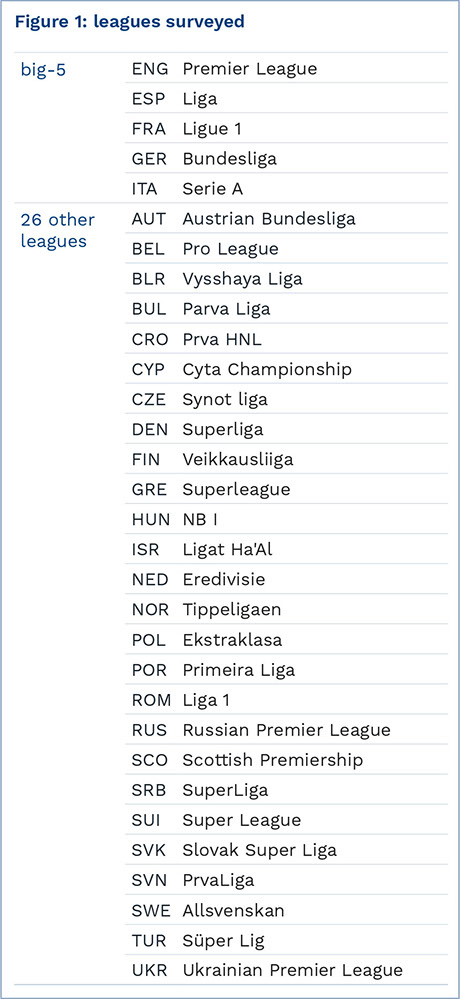
2. Change
Over the last twenty years, the percentage of players from the five major European leagues having migrated over the course of their career has more than doubled. In 1995, 24.1% of footballers in these championships already had some experience abroad. In 2015, the percentage has increased to 55.2%. For 31 European top division leagues, the percentage of migrant players has also increased from 46.3% in 2009 to 52.8% in 2016.
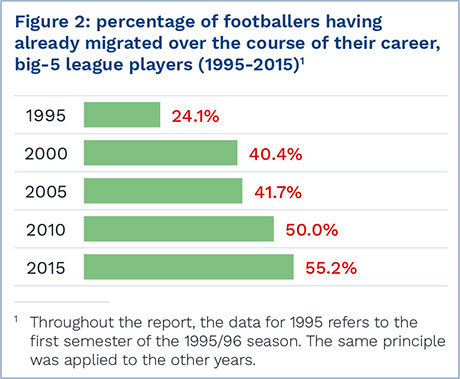
The greater international mobility of players goes hand in hand with a constant decrease in the average age of the first departure abroad. Within the five major leagues, this average has gone down from 23.2 years of age in 1995 to 21.1 years of age in 2015. Similarly, in 31 European top division championships, the average age of the first international migration has dropped from 22.2 in 2009 to 21.7 in 2016.
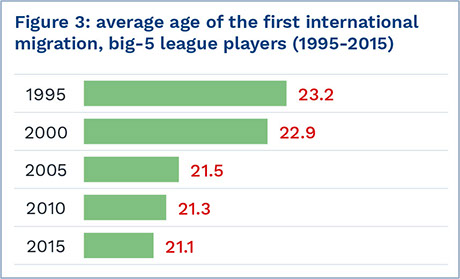
The decrease in the average age of the first departure abroad mirrors the increase in the migration of players who are minors. In twenty years, the number of footballers having left their country before their 18th birthday playing in big-5 league teams has more than tripled: from 51 in 1995 to 184 in 2015. A new record high was measured in October 2016: 195 players (two per club on average).
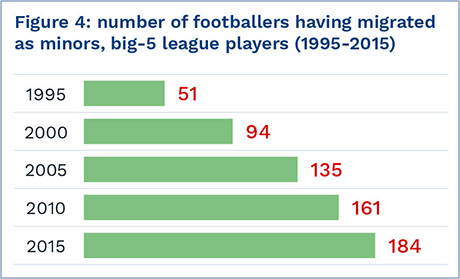
The same evolution has been observed in the 31 top division leagues of UEFA member associations studied. The number of players having migrated as minors went up from 444 in 2009 to 597 in 2016. Today, 13.8% of big-5 league players having already migrated during their career went abroad under the age of 18. This percentage is 10.1% for the 31 European championships.
3. Networks
This chapter analyses the origin of the 597 footballers present in October 2016 in 31 top division European leagues who migrated before their 18th birthday. Destination countries are also studied. We can thus highlight the main exporting countries, those importing the most minors, as well as the principle migratory channels.
As regards origin, the vast majority of migrants who are minors come from UEFA member associations (73.5%). According to the FIFA regulations, under certain conditions, European clubs are indeed permitted to recruit communitarian players from abroad already at the age of sixteen. Moreover, transfers across borders are allowed when the distance between the player’s domicile and the club’s headquarters is less than 100 km.
Belgian players are the most susceptible to experience an international transfer before 18 years of age. Swedish, French, Hungarian and Austrian talents are also often sought after from a young age by foreign European teams. Brazil and Nigeria are the non-European countries with the most players having migrated as minors.
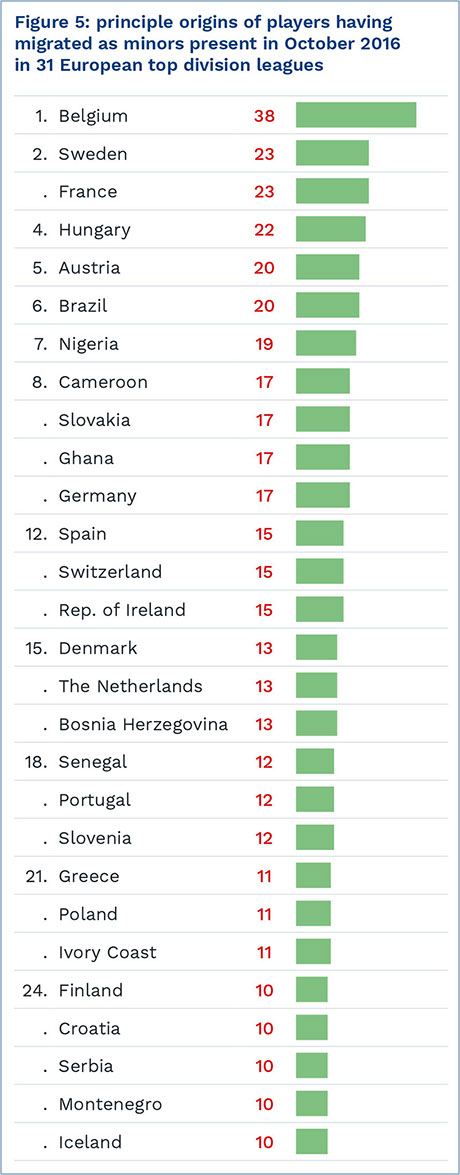
One country clearly emerges as the principle destination for players having migrated as minors: England. Out of the 597 footballers who migrated under the age of 18, 180 went to England (30.1%). The economic clout of English clubs weighs heavily in the hunt for the most promising talents. Italy is the second biggest importer of foreign minors.
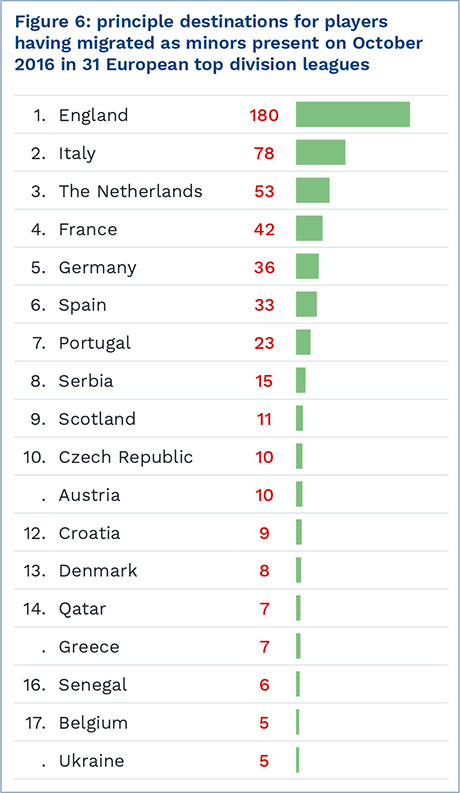
On a European level, the main axis of international migration for players under the age of 18 links Belgium and the Netherlands. The geographic proximity, the shared language, as well as the gap between the economic development of football between these two countries are the principle underlying factors in the transfer of minors.
Out of the five principle channels, four have England as destination. The countries of origin of players under the age of 18 are in this case Sweden (16 players), the Netherlands (12), Spain (12) and Ireland (11). Flows of players under the age of 18 are also numerous between Austria and Germany, Montenegro and Serbia, as well as between Belgium and France.
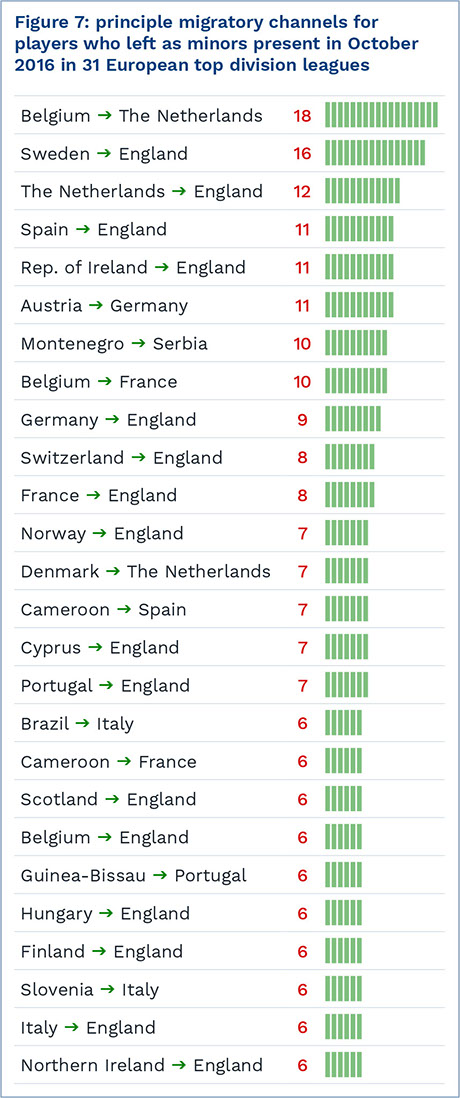
4. Conclusion
The analyses carried out by the CIES Football Observatory since its inception in 2005 shows that the European footballers’ labour market has tended towards an increasing concentration of talents. The growing economic disparities between clubs allow the wealthiest clubs to help themselves to the most promising players.
This Monthly Report shows that more and more footballers are confronted with early migration. As we have illustrated in the “Slow Foot” book (only available in french), this situation is not without its hazards. Indeed, all things being equal, players having left their country under the age of 18 have, on average, less rewarding careers than footballers who left later with more experience under their belt.
This result indicates that the premature international migration of inexperienced players poses serious risks for both the footballers concerned and the teams recruiting them. Unfortunately, in spite of all sporting logic, in an overly speculative context where numerous actors make their living out of player transfers, the international flow of minors increases with each year.
Monthly Report n°20 - December 2016 - The international mobility of minors in football